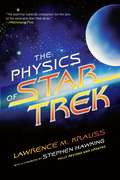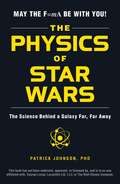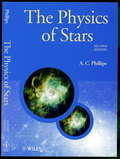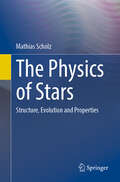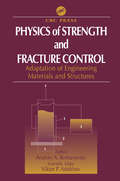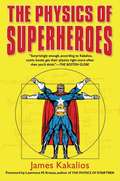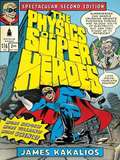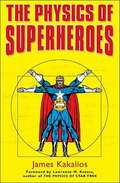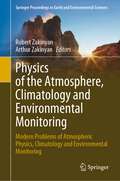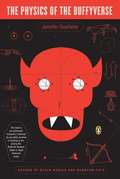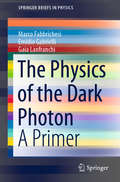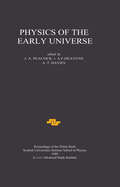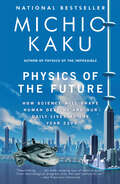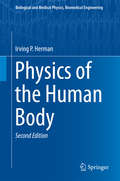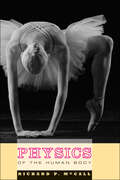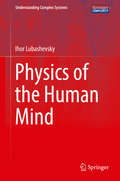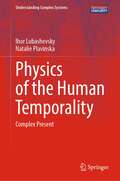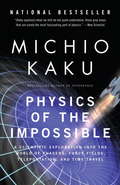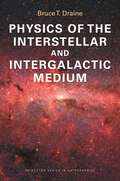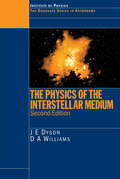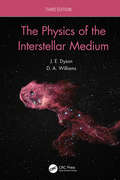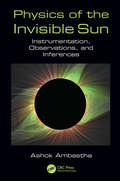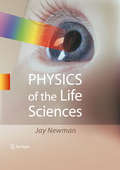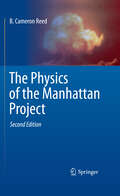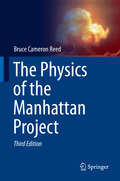- Table View
- List View
The Physics of Star Trek
by Lawrence M. Krauss Lawrence KraussWhat warps when you’re traveling at warp speed? What is the difference between a wormhole and a black hole? Are time loops really possible, and can I kill my grandmother before I am born? Anyone who has ever wondered "could this really happen?” will gain useful insights into the Star Trek universe (and, incidentally, the real world of physics) in this charming and accessible guide. Lawrence M. Krauss boldly goes where Star Trek has gone-and beyond. From Newton to Hawking, from Einstein to Feynman, from Kirk to Picard, Krauss leads readers on a voyage to the world of physics as we now know it and as it might one day be.
The Physics of Star Wars: The Science Behind a Galaxy Far, Far Away
by Patrick JohnsonExplore the physics behind the world of Star Wars, with engaging topics and accessible information that shows how we’re closer than ever before to creating technology from the galaxy far, far away—perfect for every Star Wars fan! Ever wish you could have your very own lightsaber like Luke Skywalker and Obi-Wan Kenobi? Or that you could fly through space at the speed of light like Han Solo and Poe Dameron? Well, those ideas aren’t as outlandish as you think. In The Physics of Star Wars, you’ll explore the mystical power of the Force using quantum mechanics, find out how much energy it would take for the Death Star or Starkiller Base to destroy a planet, and discover how we can potentially create our very own lightsabers. The fantastical world of Star Wars may become a reality!
The Physics of Stars (Manchester Physics Series)
by A. C. PhillipsThe Physics of Stars, Second Edition, is a concise introduction to the properties of stellar interiors and consequently the structure and evolution of stars. Strongly emphasising the basic physics, simple and uncomplicated theoretical models are used to illustrate clearly the connections between fundamental physics and stellar properties. This text does not intend to be encyclopaedic, rather it tends to focus on the most interesting and important aspects of stellar structure, evolution and nucleosynthesis. In the Second Edition, a new chapter on Helioseismology has been added, along with a list of physical constants and extra student problems. There is also new material on the Hertztsprung-Russell diagram, as well as a general updating of the entire text. It includes numerous problems at the end of each chapter aimed at both testing and extending student's knowledge.
The Physics of Stars: Structure, Evolution and Properties
by Mathias ScholzInterested students in the natural and engineering sciences, as well as high school graduates, instructors, teachers, and amateur astronomers, will find a valuable overview of the physics of stars in this book. The only prerequisite is a basic mathematical and physical background, which does not go beyond the knowledge of integral and differential calculus. In this regard, this book aims to bridge the gap with the specialized literature available on the internet, allowing readers to benefit from it. The first part traces the historical development that led to a detailed understanding of the nature of stars and their life cycles. The goal of the following chapters is to provide a pragmatic introduction to the physical processes that determine the structure and evolution of stars based on their fundamental parameters such as mass and chemical composition. It will show what can be learned from the analysis of starlight about stellar atmospheres, the fundamental role of the virial theorem in the lives of stars, and the nuclear processes deep inside stars that provide the energy that makes them shine. Finally, there will be an in-depth phenomenological look at the final stages of stellar evolution. This section will discuss states of matter that are far from experimental realization but whose properties can be, at least in principle, inferred from the observation of concrete objects such as white dwarfs or neutron stars. Exciting developments are still expected in this area in the future. Mathias Scholz is hobby astronomer. He studied physics at the University of Rostock from 1981 to 1986. Interested students in the natural and engineering sciences, as well as high school graduates, instructors, teachers, and amateur astronomers, will find a valuable overview of the physics of stars in this book. The only prerequisite is a basic mathematical and physical background, which does not go beyond the knowledge of integral and differential calculus. In this regard, this book aims to bridge the gap with the specialized literature available on the internet, allowing readers to benefit from it. The first part traces the historical development that led to a detailed understanding of the nature of stars and their life cycles. The goal of the following chapters is to provide a pragmatic introduction to the physical processes that determine the structure and evolution of stars based on their fundamental parameters such as mass and chemical composition. It will show what can be learned from the analysis of starlight about stellar atmospheres, the fundamental role of the virial theorem in the lives of stars, and the nuclear processes deep inside stars that provide the energy that makes them shine. Finally, there will be an in-depth phenomenological look at the final stages of stellar evolution. This section will discuss states of matter that are far from experimental realization but whose properties can be, at least in principle, inferred from the observation of concrete objects such as white dwarfs or neutron stars. Exciting developments are still expected in this area in the future.
Physics of Strength and Fracture Control: Adaptation of Engineering Materials and Structures
by Anatoly A. Komarovsky Viktor P. AstakhovStill passive and for the most part uncontrollable, current systems intended to ensure the reliability and durability of engineering structures are still in their developmental infancy. They cannot make corrections or recondition materials, and most material and structural failures cannot be predicted. Accidents-and catastrophes-result.Phys
The Physics of Superheroes
by James KakaliosWhat did the Flash know about the Special Theory of Relativity that you do not? Why did Ant-Man have so much difficulty with a half-filled bathtub? Kakalios combines his love for comic books and the startling accurate ways they present physics with his love of explaining physics to undergraduates and those of us destined to never get beyond the comic book stage. While filling us in on why spending your allowance on x-ray glasses is a poor investment, Kakalios covers mechanics (including Newton's Law of Gravity, the properties of matter and the cube-square law) energy (including conservation and Ampere's Law), and modern physics (including quantum mechanics, solid-state physics and tunneling phenomena). In a final section, Kakalios also contemplates a series of superhero bloopers, proving that sometimes having mutant powers and three bucks is only good for a small cappuccino.
The Physics of Superheroes: Spectacular Second Edition
by James KakaliosA complete update to the hit book on the real physics at work in comic books, featuring more heroes, more villains, and more science Since 2001, James Kakalios has taught "Everything I Needed to Know About Physics I Learned from Reading Comic Books," a hugely popular university course that generated coast-to-coast media attention for its unique method of explaining complex physics concepts through comics. With The Physics of Superheroes, named one of the best science books of 2005 by Discover, he introduced his colorful approach to an even wider audience. Now Kakalios presents a totally updated, expanded edition that features even more superheroes and findings from the cutting edge of science. With three new chapters and completely revised throughout with a splashy, redesigned package, the book that explains why Spider-Man's webbing failed his girlfriend, the probable cause of Krypton's explosion, and the Newtonian physics at work in Gotham City is electrifying from cover to cover.
The Physics of Superheroes
by James KakaliosA complete update to the hit book on the real physics at work in comic books, featuring more heroes, more villains, and more science Since 2001, James Kakalios has taught "Everything I Needed to Know About Physics I Learned from Reading Comic Books," a hugely popular university course that generated coast-to-coast media attention for its unique method of explaining complex physics concepts through comics. With The Physics of Superheroes, named one of the best science books of 2005 by Discover, he introduced his colorful approach to an even wider audience. Now Kakalios presents a totally updated, expanded edition that features even more superheroes and findings from the cutting edge of science. With three new chapters and completely revised throughout with a splashy, redesigned package, the book that explains why Spider-Man's webbing failed his girlfriend, the probable cause of Krypton's explosion, and the Newtonian physics at work in Gotham City is electrifying from cover to cover. .
Physics of the Atmosphere, Climatology and Environmental Monitoring: Modern Problems of Atmospheric Physics, Climatology and Environmental Monitoring (Springer Proceedings in Earth and Environmental Sciences)
by Robert Zakinyan Arthur ZakinyanThis proceedings book presents a discussion by leading scientists and specialists of the latest scientific results, developed methods, technologies and technical means of research and pilot work in the field of geosciences and environmental management. An important task is to familiarize young specialists, teachers, graduate students and students with the current state and the latest world achievements in this field of knowledge. Currently, there is a rapid and significant climate change, which manifests itself not only in global warming, but also in noticeable changes in other atmospheric and climatic characteristics among others.
The Physics of the Buffyverse
by Jennifer OuellettePhysics with a Buffy the Vampire Slayer pop-culture chaser In the tradition of the bestselling The Physics of Star Trek, acclaimed science writer Jennifer Ouellette explains fundamental concepts in the physical sciences through examples culled from the hit TV shows Buffy the Vampire Slayer and its spin-off, Angel. The weird and wonderful world of the Buffyverse-where the melding of magic and science is an everyday occurrence-provides a fantastical jumping-off point for looking at complex theories of biology, chemistry, and theoretical physics. From surreal vampires, demons, and interdimensional portals to energy conservation, black holes, and string theory, The Physics of the Buffyverse is serious (and palatable) science for the rest of us. .
The Physics of the Dark Photon: A Primer (SpringerBriefs in Physics)
by Marco Fabbrichesi Emidio Gabrielli Gaia LanfranchiThis book is about the dark photon which is a new gauge boson whose existence has been conjectured. Due to its interaction with the ordinary, visible photon, such a particle can be experimentally detected via specific signatures. In this book, the authors review the physics of the dark photon from the theoretical and experimental point of view. They discuss the difference between the massive and the massless case, highlighting how the two phenomena arise from the same vector portal between the dark and the visible sector. A review of the cosmological and astrophysical observations is provided, together with the connection to dark matter physics. Then, a perspective on current and future experimental limits on the parameters of the massless and massive dark photon is given, as well as the related bounds on milli-charged fermions. The book is intended for graduate students and young researchers who are embarking on dark photon research, and offers them a clear and up-to-date introduction to the subject.
Physics of the Early Universe: Proceedings of the Thirty Sixth Scottish Universities Summer School in Physics, Edinburgh, July 24 - August 11 1989 (Scottish Graduate Series)
by John A. Peacock Andrew T. DaviesThe last decade has witnessed a breathtaking expansion of ideas concerning the origin and evolution of the universe. Researchers in cosmology thus need an unprecedented wide background in diverse areas of physics. Bridging the gap that has developed, Physics of the Early Universe explains the foundations of this subject. This postgraduate-/research-level volume covers cosmology, gauge theories, the standard model, cosmic strings, and supersymmetry.
Physics of the Future: How Science Will Shape Human Destiny and Our Daily Lives by the Year 2100
by Michio KakuNATIONAL BESTSELLER • The renowned theoretical physicist and national bestselling author of The God Equation details the developments in computer technology, artificial intelligence, medicine, space travel, and more, that are poised to happen over the next century. &“Mind-bending…. [An] alternately fascinating and frightening book.&” —San Francisco ChronicleSpace elevators. Internet-enabled contact lenses. Cars that fly by floating on magnetic fields. This is the stuff of science fiction—it&’s also daily life in the year 2100.Renowned theoretical physicist Michio Kaku considers how these inventions will affect the world economy, addressing the key questions: Who will have jobs? Which nations will prosper? Kaku interviews three hundred of the world&’s top scientists—working in their labs on astonishing prototypes. He also takes into account the rigorous scientific principles that regulate how quickly, how safely, and how far technologies can advance. In Physics of the Future, Kaku forecasts a century of earthshaking advances in technology that could make even the last centuries&’ leaps and bounds seem insignificant.
Physics of the Human Body
by Irving P. HermanThis book comprehensively addresses the physics and engineering aspects of human physiology by using and building on first-year college physics and mathematics. Topics include the mechanics of the static body and the body in motion, the mechanical properties of the body, muscles in the body, the energetics of body metabolism, fluid flow in the cardiovascular and respiratory systems, the acoustics of sound waves in speaking and hearing, vision and the optics of the eye, the electrical properties of the body, and the basic engineering principles of feedback and control in regulating all aspects of function. The goal of this text is to clearly explain the physics issues concerning the human body, in part by developing and then using simple and subsequently more refined models of the macrophysics of the human body. Many chapters include a brief review of the underlying physics. There are problems at the end of each chapter; solutions to selected problems are also provided. This second edition enhances the treatments of the physics of motion, sports, and diseases and disorders, and integrates discussions of these topics as they appear throughout the book. Also, it briefly addresses physical measurements of and in the body, and offers a broader selection of problems, which, as in the first edition, are geared to a range of student levels. This text is geared to undergraduates interested in physics, medical applications of physics, quantitative physiology, medicine, and biomedical engineering.
Physics of the Human Body
by Richard P. McCallRichard P. McCall's fascinating book explains how basic concepts of physics apply to the fundamental activities and responses of the human body, a veritable physics laboratory. Blood pumping through our veins is a vital example of Poiseuille flow; the act of running requires friction to propel the runner forward; and the quality of our eyesight demonstrates how properties of light enable us to correct near- and far-sightedness. Each chapter discusses a fundamental physics concept and relates it to the anatomy and physiology of applicable parts of the body. Topics include motion, fluids and pressure, temperature and heat, speech and hearing, electrical behaviors, optics, biological effects of radiation, and drug concentrations. Clear and compelling, with a limited amount of math, McCall's descriptions allow readers of all levels to appreciate the physics of the human physique. Physics of the Human Body will help curious high school students, undergraduates with medical aspirations, and practicing medical professionals understand more about the underlying physics principles of the human body.
Physics of the Human Mind
by Ihor LubashevskyThis book tackles the challenging question which mathematical formalisms and possibly new physical notions should be developed for quantitatively describing human cognition and behavior, in addition to the ones already developed in the physical and cognitive sciences. Indeed, physics is widely used in modeling social systems, where, in particular, new branches of science such as sociophysics and econophysics have arisen. However, many if not most characteristic features of humans like willingness, emotions, memory, future prediction, and moral norms, to name but a few, are not yet properly reflected in the paradigms of physical thought and theory. The choice of a relevant formalism for modeling mental phenomena requires the comprehension of the general philosophical questions related to the mind-body problem. Plausible answers to these questions are investigated and reviewed, notions and concepts to be used or to be taken into account are developed and some challenging questions are posed as open problems. This text addresses theoretical physicists and neuroscientists modeling any systems and processes where human factors play a crucial role, philosophers interested in applying philosophical concepts to the construction of mathematical models, and the mathematically oriented psychologists and sociologists, whose research is fundamentally related to modeling mental processes.
Physics of the Human Temporality: Complex Present (Understanding Complex Systems)
by Ihor Lubashevsky Natalie PlavinskaThis book presents a novel account of the human temporal dimension called the “human temporality” and develops a special mathematical formalism for describing such an object as the human mind. One of the characteristic features of the human mind is its temporal extent. For objects of physical reality, only the present exists, which may be conceived as a point-like moment in time. In the human temporality, the past retained in the memory, the imaginary future, and the present coexist and are closely intertwined and impact one another.This book focuses on one of the fragments of the human temporality called the complex present. A detailed analysis of the classical and modern concepts has enabled the authors to put forward the idea of the multi-component structure of the present. For the concept of the complex present, the authors proposed a novel account that involves a qualitative description and a special mathematical formalism. This formalism takes into account human goal-oriented behavior and uncertainty in human perception.The present book can be interesting for theoreticians, physicists dealing with modeling systems where the human factor plays a crucial role, philosophers who are interested in applying philosophical concepts to constructing mathematical models, and psychologists whose research is related to modeling mental processes.
Physics of the Impossible: A Scientific Exploration into the World of Phasers, Force Fields, Teleportation, and Time Travel
by Michio KakuNATIONAL BESTSELLER • Inspired by the fantastic worlds of Star Trek, Star Wars, and Back to the Future, the renowned theoretical physicist and national bestselling author of The God Equation takes an informed, serious, and often surprising look at what our current understanding of the universe's physical laws may permit in the near and distant future.Teleportation, time machines, force fields, and interstellar space ships—the stuff of science fiction or potentially attainable future technologies? Entertaining, informative, and imaginative, Physics of the Impossible probes the very limits of human ingenuity and scientific possibility.
Physics of the Interstellar and Intergalactic Medium
by Bruce T. DraineThis is a comprehensive and richly illustrated textbook on the astrophysics of the interstellar and intergalactic medium--the gas and dust, as well as the electromagnetic radiation, cosmic rays, and magnetic and gravitational fields, present between the stars in a galaxy and also between galaxies themselves.Topics include radiative processes across the electromagnetic spectrum; radiative transfer; ionization; heating and cooling; astrochemistry; interstellar dust; fluid dynamics, including ionization fronts and shock waves; cosmic rays; distribution and evolution of the interstellar medium; and star formation. While it is assumed that the reader has a background in undergraduate-level physics, including some prior exposure to atomic and molecular physics, statistical mechanics, and electromagnetism, the first six chapters of the book include a review of the basic physics that is used in later chapters. This graduate-level textbook includes references for further reading, and serves as an invaluable resource for working astrophysicists.Essential textbook on the physics of the interstellar and intergalactic medium Based on a course taught by the author for more than twenty years at Princeton University Covers radiative processes, fluid dynamics, cosmic rays, astrochemistry, interstellar dust, and more Discusses the physical state and distribution of the ionized, atomic, and molecular phases of the interstellar medium Reviews diagnostics using emission and absorption lines Features color illustrations and detailed reference materials in appendices Instructor's manual with problems and solutions (available only to teachers)
The Physics of the Interstellar Medium (Series in Astronomy and Astrophysics)
by J E Dyson D A WilliamsThe book leads the advanced undergraduate through the wide range of disciplines related to an understanding of the interstellar medium and is suitable for any student studying either physics or astrophysics. The study of the interstellar medium incorporates a large range of physical More...processes on both large and small scales all of which are covered in this text. Together with the inclusion of simple models and problems at the end of each chapter this text provides a comprehensive overview and grounding in the study of the interstellar medium.
The Physics of the Interstellar Medium
by J.E. Dyson D.A. WilliamsThis third edition of The Physics of the Interstellar Medium continues to introduce advanced undergraduates to the fundamental processes and the wide range of disciplines needed to understand observations of the interstellar medium and its role in the Milky Way galaxy. The book is suitable for undergraduate students studying physics, astronomy, and astrophysics. The book also provides concise and straightforward discussions of interstellar physics and chemistry that are useful for more experienced readers. The book leads readers through the range of physical processes operating on both large and small scales that occur in the interstellar medium. It explores the relationship between the dusty, tenuous gas in interstellar space and the formation of stars and planets. This new edition also describes exciting developments in the field of astrochemistry and its interaction with interstellar physics, and the roles played by interstellar dust grains in interstellar physics and chemistry. Simple models in each chapter, together with problems at the end of each chapter, encompass interdisciplinary applications in atomic, molecular, solid state, and surface physics, and gas dynamics. This popular textbook provides a useful overview and grounding in the study of the interstellar medium and brings insight into many aspects of physics. Features An authoritative textbook in the field at this academic level Provides a wide introduction to the interstellar medium whilst remaining accessible and concise Revised throughout, presenting a modern understanding of the interstellar medium
Physics of the Invisible Sun: Instrumentation, Observations, and Inferences
by Ashok AmbasthaPhysics of the invisible Sun: Instrumentation, Observations, and Inferences provides a new updated perspectives of the dramatic developments in solar physics mainly after the advent of the space era. It focusses on the instrumentation exploiting the invisible windows of the electromagnetic spectrum for observing the outer, fainter layers of the Sun. It emphasizes on the several technical and observational challenges and proceeds to discuss the discoveries related to energetic phenomena occurring in the transition region and corona. The book begins with giving a brief glimpse of the historical developments during the pre-, and post-telescopic periods of visible and spectroscopic techniques, ground-based optical and radio observing sites. Various types of telescopes and back-end instrumentation are presented based on photometry, spectroscopy, and polarimetry using the Zeeman and Hanle effects for measurement of magnetic fields, and Doppler effect for radial velocity measurements. The book discusses theoretical and observational inferences based on detection of solar neutrinos, and helioseismology as the probes of the hidden solar interior, and tests of solar standard models. The characteristic properties and observational signatures of global solar p- and g-oscillations modes, developments in local helioseismology and asteroseismology are discussed. The role of the solar magnetic field and differential rotation in the activity and magnetic cycles, prediction methodologies, and dynamo models are described. Observing the Sun in IR at the longer, and the UV, EUV, XUV, X-rays, and gamma-rays at the shorter wavelengths are covered in detail. Observational challenges at each of these wavelengths are presented followed by the instrumentation for detection and imaging that have resulted in enhancing the understanding of various solar transient phenomena, such as, flares and CMEs. The outer most corona is described as a dynamic, expanding component of the Sun from the theoretical and observational perspectives of the solar wind. It then discusses the topics of the Interplanetary magnetic field, slow and fast solar wind, interaction with magnetised and non-magnetised objects of the solar system, the space weather and the physics of the heliosphere. The chapter on the future directions in solar physics presents a brief overview of the new major facilities in various observing windows, and the future possibilities of observing the Sun from ground and vantage locations in space. Features: Systematic overview of the developments in instrumentation, observational challenges and inferences derived from ground-based and space-borne solar projects. Advances in the understanding about the solar interior from neutrinos and helioseismology. Recent research results and future directions from ground- and space-based observations. This book may serve as a reference book for scientific researchers interested in multi-wavelength instrumentation and observational aspects of solar physics. It may also be used as a textbook for a graduate-level course.
Physics of the Life Sciences
by Jay NewmanEach chapter has three types of learning aides for students: open-ended questions, multiple-choice questions, and quantitative problems. There is an average of about 50 per chapter. There are also a number of worked examples in the chapters, averaging over 5 per chapter, and almost 600 photos and line drawings.
The Physics of the Manhattan Project
by B. Cameron ReedThe development of nuclear weapons during the Manhattan Project is one of the most significant scientific events of the twentieth century. This book, prepared by a gifted teacher of physics, explores the challenges that faced the members of the Manhattan project. In doing so it gives a clear introduction to fission weapons at the level of an upper-level undergraduate physics student. Details of nuclear reactions, their energy release, the fission process, how critical masses can be estimated, how fissile materials are produced, and what factors complicate bomb design are covered. An extensive list of references and a number of problems for self-study are included. Links are given to several spreadsheets with which users can run many of the calculations for themselves.
The Physics of the Manhattan Project
by Bruce Cameron ReedThe development of nuclear weapons during the Manhattan Project is one of the most significant scientific events of the twentieth century. This revised and updated 3rd edition explores the challenges that faced the scientists and engineers of the Manhattan Project. It gives a clear introduction to fission weapons at the level of an upper-year undergraduate physics student by examining the details of nuclear reactions, their energy release, analytic and numerical models of the fission process, how critical masses can be estimated, how fissile materials are produced, and what factors complicate bomb design. An extensive list of references and a number of exercises for self-study are included. Links are given to several freely-available spread sheets which users can use to run many of the calculations for themselves.
